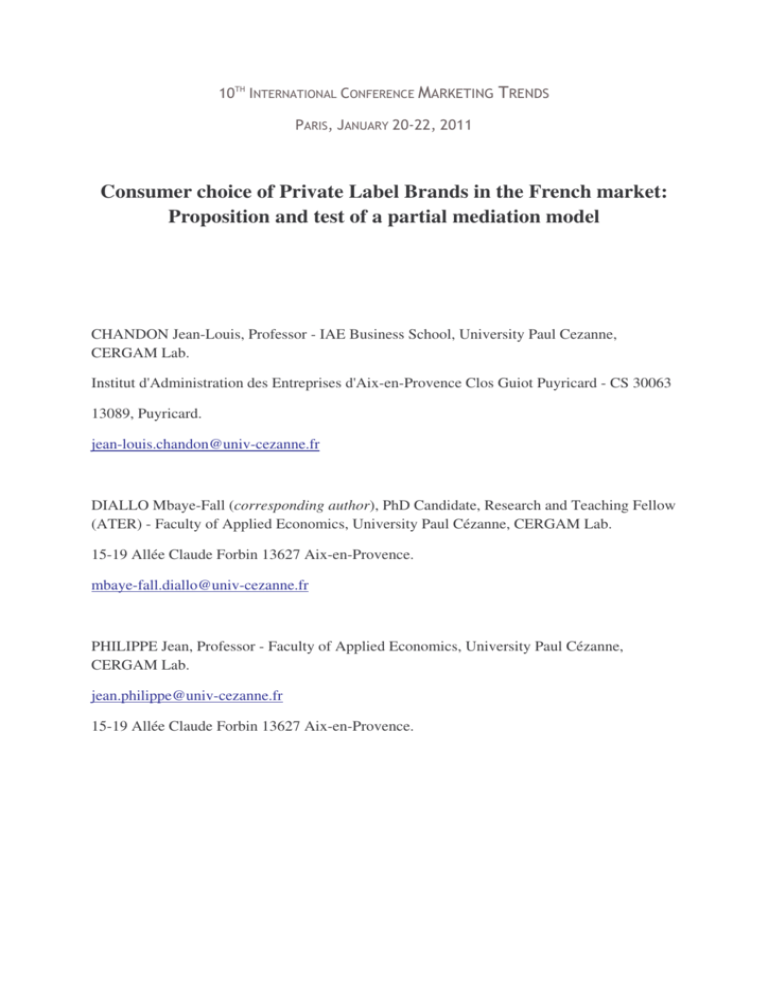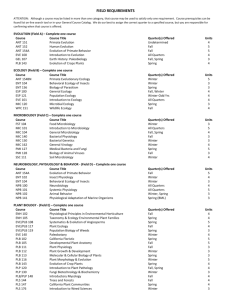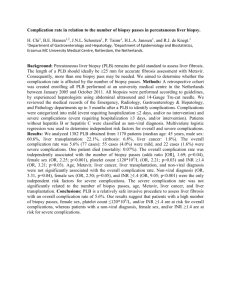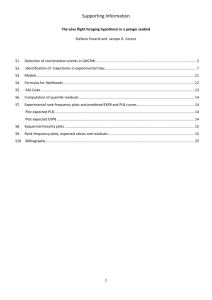Consumer choice of Private Label Brands in the French market
advertisement

Consumer choice of Private Label Brands in the French market: Proposition and test of a partial mediation model CHANDON Jean-Louis, Professor - IAE Business School, University Paul Cezanne, CERGAM Lab. Institut d'Administration des Entreprises d'Aix-en-Provence Clos Guiot Puyricard - CS 30063 13089, Puyricard. jean-louis.chandon@univ-cezanne.fr DIALLO Mbaye-Fall (corresponding author), PhD Candidate, Research and Teaching Fellow (ATER) - Faculty of Applied Economics, University Paul Cézanne, CERGAM Lab. 15-19 Allée Claude Forbin 13627 Aix-en-Provence. mbaye-fall.diallo@univ-cezanne.fr PHILIPPE Jean, Professor - Faculty of Applied Economics, University Paul Cézanne, CERGAM Lab. jean.philippe@univ-cezanne.fr 15-19 Allée Claude Forbin 13627 Aix-en-Provence. Consumer choice of Private Label Brands in the French market: Proposition and test of a partial mediation model Abstract Private Label Brands (PLBs) experienced a phenomenal growth in various product categories during the past years. Many factors have been highlighted to explain PLB rise but a conceptual model integrating these factors is lacking. The aim of this research is to investigate factors affecting PLB choice in the French retail market and to propose a conceptual model of the determinants of PLB choice in this market. Data were collected from 140 and 266 respondents in two consumer surveys. We used exploratory and confirmatory factor analysis to test the relationships between the variables of interest. Results show that five mains variables have a significant influence on PLB choice in a partial mediation model: attitude toward PLBs, PLB perceived price-image, store image perceptions, PLB purchase intention and value consciousness. Attitude toward PLBs and value consciousness have only a direct effect on PLB choice, while the effect of store image is totally mediated by purchase intention. Important theoretical and managerial implications of these findings are presented and discussed. Key words: Private Label Brands, Consumer choice, Store image perception, PLB purchase intention, Structural Equation Modeling Introduction Over the past two decades, Private Label Brands (hereafter PLBs) have been increasingly investigated by marketing scholars and focused retail managers’ interest (Hyman and al., 2010). PLBs experienced a phenomenal growth in various product categories during the past years (Baltas and Argouslidis, 2007). There are many incentives for retailers to create private label brand programs such as building store loyalty, increasing store traffic, enhancing negotiating strength with manufacturers, etc. (Baltas, 1997; Baltas and Argouslidis, 2007; Binninger, 2008). In Western Europe, Private Label Brands’ penetration exceeds 50% of sales by volume in Switzerland and more than 35% in major markets like the United Kingdom, Belgium, Germany and Spain (Planet Retail, 2007; Lamey and al., 2007). Retailers are facing strong competitive pressure leading them to launch an ever increasing number of PLBs. Today, PLBs are growing faster than manufacturer brands (Kumar and Steenkamp, 2007). According to Grewal and Levy (2009, p.523), “we saw increasing evidence of store brands with similar quality levels coupled with 10–15% lower prices than those charged by national brands [hereafter, NBs]”. For retailers, PLBs become a reliable means to increase sales quickly at a relatively low cost. Simultaneously, consumer are today willing to purchase private brands products (PLMA, 2009) and are delighted to have PLBs ranges available in stores (Binninger, 2008). Several factors drive consumer willingness to purchase PLB products such as demographic factors (Baltas and Argouslidis, 2007; Montaner and Martinez, 2008), economic factors (Lamey and al., 2007) and psychographics (Burton and al., 1998; Garretson and al., 2002; Jin and Suh, 2005; Kara and al., 2009). Demographic factors include household income, the number of children in the household, gender, etc. Economic factors are related to the economic cycle while psychographics involve value consciousness, risk awareness, price-quality inferences, self-smart shopper perceptions, etc. The aim of this paper is to investigate the influence of four variables - store image perceptions, value consciousness, attitude towards PLBs and PLB price image - on PLB choice in the French context. The intended contribution of this paper is three-fold. First, we lay the emphasis on image factors (store image and PLB price-image) while previous research focused mainly on perceptual, demographic and psychographic ones (Jin and Suh, 2005 Garretson et al., 2002; etc.). Second, we propose and validate a conceptual model of consumer choice of PLB in the French market while previous were mainly focused on the strategic role of PLBs in the relationships between retailers and manufacturers (e.g., Bergès-Sennou, 2006; Bergès-Sennou et al., 2009; Cadenat and Pacitto, 2009). Third, we test two alternative models (full mediation model and a partial mediation one) and showed that the latter is better conceptually and empirically. The organization of the paper is as follows: first, we present the theoretical framework and the hypotheses development; second, we develop the research methodology; third, the results are detailed and discussed; and finally, we propose some theoretical and managerial implications and point out limitations and research orientations for future studies. Theoretical framework and hypotheses development According to Jin and Suh (2005), most of the consumer factors associated with PLB purchase behavior can be grouped in three categories: personality (e.g., Burton and al., 1998), perceptual (e.g., Garretson and al., 2002; Kara and al., 2009), and socioeconomic (e.g., Baltas and Argouslidis, 2007; Martinez and Montaner, 2008). In previous studies, consumer perceptual characteristics such as price-quality perception, perceived quality, value consciousness, price consciousness, perceived price fairness, smart-shopper self perception, general deal proneness, etc. were correlated with PLB purchase (Garretson and al., 2002; Kara and al., 2009). In this research, we take into account image factors that have not been widely investigated within the context of PLB purchase behavior. Store Image Perceptions Several conceptualizations of store image have been proposed in previous research. These conceptualizations changed over time, which indicates the difficulties encountered in defining the construct (Hartman and Spiro, 2005). One of the earlier definitions of store image was given by Martineau (1958). He posited that the store image is defined in the shopper’s mind, partly by the functional qualities and partly by an aura of psychological attributes. Store image develops from consumers’ objective and subjective perceptions learned over time. Subsequent conceptions of store image have taken into account the interactions among attribute perceptions (Lindquist, 1974). In this respect, a store image is not only an aggregation of the various perceptions of attributes but also a function of the importance weights and interactions among these attributes (Hartman and Shapiro, 2005). Lindquist (1974) conceptualized store image structure across nine dimensions – merchandise, service, clientele, physical facilities, convenience, promotion, store ambience, institutional factors, and post transaction satisfaction. These dimensions have been studied and discussed and most of them are incorporated into store image scales (e.g., Grewal and al., 1998; Smeijn and al., 2004; Vahie and Paswan, 2006). According to the cue utilization theory, store image can be a determinant of product quality (Richardson and al., 1994; Smeijn and al., 2004). Besides, we can consider PLBs to be a brand extension of the store. Brand extension research supports the idea that store associations and evaluations can be generalized to PLB (Collins-Dodd and Lindley, 2003). In fact, “grocery stores are facing problems in differentiating themselves due to the lack of a perceived core product/service and the need to address the broadest possible range of consumers and purchase situations” (Smeijn and al., 2004). Because the store image perceptions provide a highly relevant cue for the PLB, they can act like the original brand, providing a basis for overall PLB quality (Collins-Dodd and Lindley, 2003). As PLB perceived quality is related to PLB purchase intention and PLB choice (Burton and al. 1998, Garretson and al., 2002; Jin and Suh, 2005), we anticipate that store image perceptions will influence PLB purchase intention and PLB choice. Therefore: H1a: Consumers’ store image perceptions will have an influence on PLB purchase intention. H1b: Consumers’ store image perceptions will have an influence on PLB choice. Value Consciousness Previous definitions in the literature indicate that perceived value is derived from a comparison between the expected benefits of a product and the sacrifices that a consumer would have to make in order to assure those benefits (Monroe and Krishnan, 1985). According to Zeithaml (1988), customers define the term value in a different ways. For this author, a first group of consumers considers value simply as “low price” while a second group only takes into account “the benefits they receive from the products”. A third group of consumers considers value as “the quality they get for the price they pay”. A fourth group states that value is “what they get for what they give”. Based on the differences in these expressions of value consciousness, we can say that this concept is differently perceived. However, most of the definitions provided in previous research report the expression “quality one gets for the price one pays” (Lichtenstein al., 1993; Sweeney and Soutar, 2001; Jin and Suh, 2005; etc.). In the marketing literature, it is well established that the intention to buy a given brand is strongly influenced by the perceived monetary sacrifice, in conjunction with the perception of product quality (Jin and Suh, 2005). Empirical research has confirmed that value consciousness is positively related to PLB purchase behavior and to PLB purchase attitude (Burton et al., 1998; Garretson and al., 2002; Jin and Suh, 2005). More recently, Kara and al. (2009) provided further evidence that value consciousness is positively related to PLB purchase behavior. PLBs have achieved great quality improvement in recent years and more consumers accept that PLBs carry good quality yet much lower price, hence good value, compared to NBs. Therefore, other things being equal, greater consumer value consciousness will lead to higher levels of PLB purchase intention and PLB choice. From this, we anticipate that: H2a: Value consciousness will have a positive influence on PLB purchase intention. H2b: Value consciousness will have a positive influence on PLB choice. PLB Price-Image Price-image perceptions are considered as an integral part of a retailer’s store image (Lindquist, 1974). To the best of our knowledge, PLB price-image has not yet been defined in previous research. However, we can infer its definition from the definition of store priceimage. Store price-image is defined as “a global representation of the relative level of prices” (Martineau, 1958; Mazurky and Jacoby, 1986; Coutelle, 2000; etc.). Following this definition, we can define PLB price-image as a global representation of the relative level of PLB products prices for a given retailer. Most researchers defined and conceptualized price-image with one dimension, i.e., low prices or price-level image (e.g., Zeithaml, 1988; Cox and Cox, 1990). However, other researchers consider this concept as multidimensional. For instance, Coutelle (2000) found three dimensions (price security, value and basket) and Zielke (2010) identified five different components of price-image (price-level image, value for money, price perceptibility, price processibility, evaluation certainty). The price variable has a prominent place in the consumer choice process, especially for PLB choice. Within the variable price, consumers look for information enabling them to carry out choices available and analyze all kinds of brands in the market (NBs and PLBs). Price in relation with PLBs has been largely discussed in previous research and empirical results showed that it is an important factor in choosing a PLB product (Burton and al., 1998; Garretson and al, 2002). As for PLB price-image, it can be a reference for the consumer when purchasing a PLB product. In fact, retailers are now offering different kinds of PLB product ranges such as premium PLBs, standard PLBs, etc. with different levels of quality and different levels of perceptions (Kumar and Steenkamp, 2007). For instance, Laaksonen and Reynolds (1994) found four tiers of PLBs ranging from low quality, no-name generics to medium quality, quasi-brands to comparable quality, me-too products to premium quality, and high value-added own-brands. From previous research, we know that PLBs are a key element of store image (Collins-Dodd and Lindley, 2003; Vahie and Paswan, 2006), which is supposed to influence PLB purchase behavior via PLB perceived quality (Richardson and al., 1994). So, we can expect that consumers will be influenced by PLB price-image perceptions when purchasing PLB products. Therefore: H3a: The better PLB price-image, the higher PLB purchase intention H3b: The better PLB price-image, the more PLB choice Attitude towards PLBs An attitude is generally regarded as a set of beliefs, experiences and feelings forming a predisposition to act in a given direction. It is found to have an effect on intentions and consumer behavior (Fishbein and Ajzen, 1975; Ajzen, 1985). It is considered as a psychological tendency expressed by evaluating a product or a brand in a favorable or unfavorable way. Attitude towards a brand is a key concept in consumer behavior. Indeed, the importance of attitude is explained by its basic psychological functions. Thus, according to Katz (1960), four major functions of attitude can be distinguished: the utility function which leads consumer to make choices and satisfy their needs; the function of value expression which is important when involving goods are included in the buying process; the function of defending the ego of individuals which matters when risky products are concerned; and the function of organizing knowledge which allows to organize better knowledge and information received. Attitude towards PLB (i.e., PLB attitude) is defined as a predisposition to respond in a favorable or unfavorable manner due to product evaluation, purchase evaluations, and/or selfevaluations associated with private label grocery products (Burton and al., 1998). Consumers appear to hold generalized attitudes toward PLBs that influence their propensity to purchase PLBs in general (Collins-Dodd and Lindley, 2003). Studies attempted to identify PLB buyers on the basis of demographics, psychographics, however, evidence was inconclusive (Martinez and Montaner, 2008). PLBs have been for a long time affected by negative stereotypes such as low quality goods designed for low income consumers (Laaksonen and Reynolds, 1994; Guerrero and al., 2000). For this reason, PLBs have low market shares in some product category such as shampoo and can be found mainly in low added value product ranges. So, consumer attitude towards PLB was often negative at the beginning of PLBs offer. However, this attitude towards PLBs is now changing as retailers are launching higher value added product. For instance, in the United Kingdom, Tesco has premium PLBs that can compete with manufacturer brands on a quality basis (Kumar and Steenkamp, 2007). Improved quality of PLB products has lead consumers to develop stronger preferences for PLBs in most product categories (Guerrero and al., 2000; Huang and Huddleson, 2009). That is why we anticipate that: H 4a: The attitude towards PLBs will have a positive influence on PLBs purchase intention. H 4b: The attitude towards PLBs will have a positive influence on PLB choice. PLB Purchase Intention Purchase intention data are routinely used by marketing managers to make strategic decisions about both new and existing PLB products, and the marketing programs that support them. It refers to a consumer tendency to purchase the brand routinely in the future and resist switching to other brands. In the cognitive-affective model, many perceptual factors are supposed to influence consumers’ buying behavior and purchase intention. Consumers may intend to purchase a particular PLB because they perceive the brand offers the right pricequality relation, or other benefits such as a good price image (Zielke, 2010). Purchase intention has been widely used in the literature as a predictor of subsequent purchase and the concept was found to be strongly correlated with actual behavior (Fishbein and Ajzen, 1975; Ajzen, 1985). In this respect, PLB purchase intention would lead directly to PLB purchase. Sometimes, it has been used as a proxy of PLB purchase, yielding some confusion between the two variables (Jin and Suh, 2005). However, they differ, PLB purchase intention being a projection in the future whereas PLB purchase is an action. Simply put, anything else being equal, consumers’ PLB purchase intention may influence PLB choice. Hence, we derive that: H5: PLB purchase intention will have a positive influence on PLB choice. Factors affecting consumer behavior (PLB choice here) have been considered differently in previous research. For instance, the Theory of Reasoned Action - TRA (Ajzen and Fishbein, 1975) and its updated version i.e., the Theory of Planned Action - TPA (Ajzen, 1985) posit that individual behavior is driven by behavioral intentions where behavioral intentions are a function of an individual's attitude toward the behavior and subjective norms surrounding the performance of the behavior (see figure 1). Guerrero and al., (2000) tested a simplified model using the TRA framework in the Spanish market to investigate consumer behavior toward PLBs. However, other scholars formulated criticisms on TRA (See Terry and al, 1994). Some antecedents might directly affect consumer behavior without the mediation of purchase intention. This position is advocated by the theory of impulsive purchase (Hoch and and Lowenstein, 1991). For some other antecedents, the mediation by intention might not be total leaving the possibility of two paths, a direct path from antecedent to behavior and an indirect path mediated by intention. One way to advance the debate among these theoretical frameworks is to allow for partial mediation, thus providing a richer framework as in model 2 (See Fig. 2). Figure 1 - Conceptual model with total mediation (Model A) SIP* VC* PLBPI* ATPLB PLBCH* * PLBPIM* Figure 2: Conceptual model with partial mediation (Model B) SIP * PLBPIM* PLBPI* PLBCH* VC* ATPLB* * SIP=Store Image Perceptions; VC= Value Consciousness; ATPLB=Attitude towards PLB; PLBPIM=PLB Price-Image; PLBPI=PLB Purchase Intention; PLBCH=PLB Choice. Figure 1 summarizes a conceptual model by which store image perception (SIP), Value consciousness (VC), attitude towards PLB ATPLB) and PLB price image (PLBIM) are formative antecedents of PLB purchase intention (PLBPI) which in turn explain PLB choice (PLBCH). This model makes the strong hypothesis that no direct link of the antecedents of purchase intention affects purchase behavior (Fishbein and Ajzen, 1975). It is a total mediation model. Figure 2 describes the concurrent model that allows for some (or all) direct relationships among the four antecedents and purchase behavior. This is the partial mediation model as it is clear from our hypotheses that we postulate a partial mediation one. Research methodology Data collection and sample We sampled PLB consumers who regularly shops at hypermarkets in three French southern towns. Data were collected using a self-administered questionnaire in two different periods. The criteria for participating were that the respondent must be at least 20 years old and fully or partially in charge of the household purchases of food and groceries. Respondent selection was based on quota by sex, age and place of residence in order to ensure some representativeness. The questionnaire was structured as follows. The first part contained general questions to ascertain that respondents were regular PLB consumer and able to distinguish between PLBs and National Brands. The second part included scale items. The third part covered general socio-demographic questions such as age, gender, income groups, etc. After deletion of questionnaire not properly filled, 140 usable questionnaires were retained for exploratory factor analysis and 266 for confirmatory factor analysis. Most of the respondents in the first and second sample are women (respectively 61.4% 59%). About half of them (respectively 50.7% and 51.9%) are less than 26 years old. Consumers with monthly household income less than €2000 represent respectively 45.8% and 44.3% of the respondents. The majority of respondents are under-graduated (respectively 68.6% and 57.1%). Table 1 presents the main sample characteristics for each data set. Table 1: Sample characteristics (%) Gender (%) Categories First data collection (N=140) Second data collection (N= 266) Age (%) Household income /month (%) Education Men Wo men < 26 2634 3549 > 49 < €1000 €1000 -2000 €2001 -4000 >€ 4000 High school or less Undergradua te Master and + 38.6 61.4 50.7 7.1 25.0 17.1 22.9 22 .9 34.3 20.0 23.6 68.6 7.8 41.0 59.0 51.9 2.6 30.1 15.4 12.0 32.3 41.7 13.9 31.2 57.1 11.7 Measures We developed the survey instrument following a comprehensive review of the relevant literature. For each latent variable, we adapted an existing scale or gathered a set of items from past research in the retail sector and from a pilot study. Items which were originally in English were subjected to a translation and back translation process from English to French by a two bilingual experts. We then assessed the content and face validity of the items with three academic experts who were familiar with the topic under investigation. In a series of face-to-face settings, we pre-tested the questionnaire with 15 PLB buyers in order to test response format and clarity of instructions. After that, we checked for consistency of each item with the original version. Except for PLB choice, the items used to operationalize each construct were developed based on previous literature in the retail sector. All items were rated on a 7 point-Likert scale ranging from 1 “strongly disagree” to 7 “strongly agree”. All of the statements were positive; therefore high scores/levels of agreement could also be taken to represent some degree of positive assessment with the item concerned. However, because some of our variables had right-skewed distributions of answers, they departed from normality in the first data collection. As all respondents were PLB buyers, they tended to overestimate some variables mainly associated with PLB purchase behavior. In our case, three variables were right- skewed: PLB choice, PLB purchase intention and PLB value consciousness. This kind of situation was observed in past research in the French market (Merle and al., 2008). The right-skewness of these variables impacted our results as only fit indices of these three variables were not satisfactory in the first set of data. Based on the past literature (De Vellis, 2003; Merle and al, 2008), we calibrated the skewed scales in the second data collection1. 1 All the scales were symmetrical in the 1st data collection (3 negative points, 1 neutral point and 3 positive points). Because of right-skewness problems, asymmetrical scales were used for Value consciousness, PLB purchase intention and PLB choice in the 2nd data collection (1 negative point, 1 neutral point and 5 positive points To measure store image perceptions, 7 items from Grewal and al., (1998) were employed. The internal consistency (Cronbach alpha) of the scale has been found to be high (0.94) by these authors. Value consciousness was measured by 5 items taken and adapted from Garretson and al. (2002). PLB price image was measured using 9 items adapted from Coutelle (2000). Attitude towards PLBs was measured with 5 items from Garretson and al. (2002). PLB purchase intention was measured with 5 items adapted from previous research (Grewal, 1998; Jin and Suh, 2005). The dependent variable, PLB choice was measured with 5 items from Ailawadi and al. (2001) and Kara and al. (2009). In the previous literature, PLB choice was measured with a single item (e.g., Batra and Sinha, 2000). However, single items are not recommended in structural equation models as one can’t assess their scale reliability (see Bergkvist and Rossiter, 2007). Appendix 1 shows the final list of items used after the statistical purification process. Results Scale validation The scale validation process consisted of two stages (exploratory factor analysis and confirmatory factor analysis) and was based on the paradigm of Churchill (1979) and its updated version (Gerbing and Anderson, 1988). Exploratory Factor Analysis To determine the patterns of factor loadings for each measurement model, we used two exploratory factor analyses (EFA). The purpose of an EFA is twofold: to identify the dimensions of a concept and to purify the initial pool of items. In the EFA process, we used factor analysis (Principal Component Analysis), dimensionality assessment (MAP test of Velicer and Horn parallel test) and reliability assessment (Cronbach alpha) to evaluate convergent validity of the scales, as recommended by Gerbing and Anderson (1988). In the first exploratory analysis, 36 items of the six constructs were analyzed. The KMO values were between 0.74 and 0.83 for all constructs. During the EFA process, we deleted initial items that didn’t load well on one dimension (loading < 0.4). Items with communalities less than 0.4 were also deleted. After this process, 4 items remained for each construct. These items loaded significantly on only one factor with eigenvalue larger than 1. The variance explained by these factors ranged from 60% to 75%. All constructs obtained Cronbach alpha larger than 0.7. The results are shown in Table 2. Table 2: Exploratory factor analyses of the six scales in the two samples Items 1st data collection (N1=140) 2nd data collection (N2=266) Factor loadings R² Factor loadings R² SIP1 0.83 0.69 0.86 0.74 SIP2 0.84 0.70 0.82 0.68 SIP5 0.74 0.56 0.81 0.66 SIP6 0.78 0.61 0.83 0.69 VC1 0.85 0.72 0.92 0.84 VC2 0.85 0.73 0.84 0.71 VC3 0.87 0.75 0.88 0.78 VC4 0.92 0.85 0.90 0.82 ATPLB2 0.74 0.55 0.81 0,66 ATPLB3 0.77 0.59 0.86 0,75 ATPLB4 0.85 0.73 0.83 0,69 ATPLB5 0.74 0.55 0.84 0,71 PLBPIM 3 PLBPIM 4 PLBPIM 5 PLBPIM 6 PLBPI1 0.79 0.63 0.84 0.71 0.82 0.67 0.86 0.75 0.83 0.70 0.86 0.75 0.78 0.61 0.80 0.65 0.90 0.81 0.91 0.83 PLBPI2 0.87 0.76 0.86 0.74 PLBPI3 0.89 0.80 0.88 0.77 PLBPI5 0.68 0.46 0.80 0.65 PLBCH1 0.89 0.79 0.86 0,74 PLBCH3 0.90 0.82 0.81 0,66 PLBCH4 0.83 0.69 0.80 0,64 PLBCH5 0.85 0.72 0.81 0,66 % of VE* 64.5 77.1 60.9 65.9 71.2 75.9 60.5 79.4 70.4 71.9 75.3 68.2 Cronbach 0.81 0.90 0.78 0.82 0.85 0.89 0.85 0.91 0.85 0.86 0.88 0.84 *% of variance extracted by the first factor. Loadings below |0.4| were not printed We replicated the exploratory factor analysis on the second set of data. As expected, the factorial structure obtained in the first data set holds well in the second data set with mostly better factor loading, percentage of extracted variance and Cronbach alpha values (Table 2). Confirmatory Factor Analysis (CFA, N=266) In the confirmatory analysis, we distinguished between measurement model and structural model, as advocated by Anderson and Gerbing (1988). We first assessed measurement models before evaluation of the structural model. This two-step approach allows us to pinpoint the week point of either the measurement or the structural part of the model. We used maximum likelihood (ML) on the covariance matrix, with AMOS 18. However, as the ML method is sensitive to missing values, outliers and multivariate normality violation, we verified that these assumptions were met. No missing value or critical outlier was found and the Mardia multivariate kurtosis was 16 (c.r. = 3.7). To evaluate models’ fit, three types of fit indices (absolute, incremental and parsimonious) were used following the benchmarks suggested by the experts (Hu and Bentler, 1999; Steiger, 2007; Jackson and al., 2009; Kline, 2010). The measurement models show acceptable fit: 2 statistics are low and 2 /df ratios are less than 3 (Table 3). Root mean square errors of approximation (RMSEA) values range from 0.009 to 0.062 and Comparative fit index (CFI) values range from 0.98 to 1. Table 3: Fit indices of measurement models Absolute Indices Incremental Indices Parsimony Indices Scales X2 (df) p RMSEA SRMR TLI CFI X2 /df SIP* VC* ATPLB* PLBPIM* 3,94 (2) 2,03 (2) 4,05 (2) 268 (2) 0,13 0,36 0,13 0,26 0,061 0,009 0,062 0,036 0,016 0,008 0,015 0,012 0,98 1 0,96 0,99 0,99 1 0,98 0,99 1 ,97 1,019 2,02 1,34 AIC2 (indep. model) 19,94 (459) 18,03 (756) 20,05 (483) 18,68 (519) PLBPI* PLBCH* 3,41(2) 3,08 (2) 0,18 0,21 0,052 0,045 0,014 0,014 0,99 0,99 0,99 0,99 1,70 1,54 19,41 (639) 19,08 (435) * SIP=Store Image Perceptions; VC=PLB Value Consciousness; ATPLB=Attitude towards PLB; PLBPIM=PLB Price Image; PLBPI=PLB Purchase Intention; PLBCH=PLB Choice. Reliability and validity of the scales Internal consistency was adequate with Cronbach alpha larger than 0.78 for the six scales, on the two data sets (Table 2). Furthermore, the composite reliability (Joreskog ) was above the recommended cut off criteria (0.7) for the six scales (Table 4). Content and facial validity of the constructs have been assessed by using well known scales. Translation and back translation, as well as evaluation by three experts and a sample of 15 PLB consumers resulted in a good items’ comprehension. Convergent validity is demonstrated when the latent variable shares more than 50% of its variance with its measures, i.e., when the average extracted variance -AVE is greater than 0.5 (Fornell and Larcker, 1981). Convergent validity of the constructs is fulfilled as AVE ( VC) is greater than 0.5 for each of them (Table 4). Besides, all SMCs (R2) are above 0.5, which provides further evidence of convergent validity of the 2 Compared to the independent model (without any linear relationship between the variables). The model with smaller AIC value is better for two given models. constructs (Bagozzi and Yi, 1988). Discriminant validity is supported when a construct has its variance better explained by its measurement indicators than by any other construct. To assess discriminant validity, we compared the squared correlations between the constructs to the AVE. Results presented in Table 4 show that discriminant validity is supported as all VC are greater than squared correlations between constructs (Fornell and Larcker, 1981). Table 4: Discriminant and convergent validity Composite Reliability Constructs SIP VC ATPLB PLBPIM PLBPI PLBCH Convergent validity Joreskog 0.85 0.91 0.86 0.87 0.89 0.84 VC 0.59 0.72 0.60 0.62 0.67 0.57 Discriminant validity SIP 0.593 0.55 0.38 0.25 0.32 0.42 VC 0.72 0.41 0.34 0.35 0.46 ATPLB PLBPP PLBPI PLBCH 0.60 0. 35 0.51 0.53 0.62 0.39 0.54 0.67 0.55 0.57 Note: SIP=Store Image Perceptions; VC=PLB Value Consciousness; ATPLB=Attitude towards PLB; PLBPIM=PLB Price Image; PLBPI=PLB Purchase Intention; PLBCH=PLB Choice. Structural model and hypothesis testing We examine now the hypothesized relationships among constructs for the two alternative models of PLB choice. The models are assessed in accordance with previous literature (cf. Schlegel and al., 1992). As illustrated in Table 5, the two models show a good fit to the data. 2 For model A, for model B, 2 = 399.316, df=241, p<0.001; RMSEA=0.050; CFI=0.96 and = 331.914, df=237, p<001; RMSEA=0.039; CFI=0.97 and 2 2 /df=1.65 while /df=1.40. We can notice that model B (partial mediation) fits better the data than model A (full mediation). In fact, using the A[ 3 2 2 test of difference, model B is significantly better than model =67.4 (4), p<.01]. VC (% of variance extracted by each construct with its indicators) in the diagonal; Off diagonal values correspond to the squared correlations between the constructs (% of variance shared between the constructs). Table 5: Model fit Fit indices 2 (df); p-value /df ratio SRMR RMSEA CFI AIC 2 Model A (full mediation) 399.316 (241); p<0.01 1.65 0.06 0.050 (0.041; 0.058) 0.96 517 Model B (partial mediation) 331.914 (237); p<0.01 1.40 0.03 0.039 (0.028; 0.048) 0.97 457 Now that we have demonstrated that the partial mediation model is clearly superior to the full mediation model, we pursue a detailed analysis, relation by relation, to see if the partial mediation model can be improved on both theoretical and empirical grounds (cf. McCallum and al., 1992), thus allowing some relations to be totally mediated by intention while some other relations would be only partially mediated or not mediated at all. Two modifications are made. First, the direct link between ‘Store image perceptions’ and ‘PLB choice’ (H1b) is dropped as it has been widely recognized that consumers use ‘store image perceptions’ only to make inference about PLB quality (cue utilization theory, see Richardson and al., 1994). Second, the indirect link between ‘Attitude towards PLBs’ and ‘PLB purchase intention’ is also dropped because, when consumers have a positive attitude toward a PLB, that attitude leads them directly to PLB use (or PLB rejection) (see Burton and al., 1998). The re-specified model is called model C. The fit to the data is slightly worse than the fit of model B. Table 6 presents fit indices and hypotheses testing of Model C. All the hypotheses are supported except H2a (influence of value consciousness on PLB purchase intention). Table 6: Model C Partial mediation re-specified Fit indices 366.54 (239) <0.001 P 0.05 SRMR 0.045 RMSEA 0.96 CFI 0.96 TLI 488.545 AIC 1.53 X2/df 2 (df) Hypotheses H1a : SIP PLBPI H2a : VC PLBPI H2b : VC PLBCH H3a : PLBPIM PLBPI H3b : PLBPIM PLBCH H4b : ATPLB PLBCH H5 : PLBPI PLBCH Test of hypothesis Standardized estimate 0.25* 0.16 0.19* 0.42* 0.31* 0.24* 0.28* Validated Yes No Yes Yes Yes Yes Yes *p < 0.01. SIP=Store Image Perceptions; VC=PLB Value Consciousness; ATPLB=Attitude towards PLB; PLBPIM=PLB Price Image; PLBPI=PLB Purchase Intention; PLBCH=PLB Choice. Figure 3: The path diagram of Model C 2 (df)=366,54 (239), p<0.001, SRMR=0.03, RMSEA=0.045, CFI=0.96, TLI=0.96, 2 /df=1.53 SIP PLBPIM PLBPI PLBCH VC ATPLB Notes: **p<0.01; SIP=Store Image Perceptions; VC= Value Consciousness; ATPLB=Attitude towards PLB; PLBPIM=PLB Price Image; PLBPI=PLB Purchase Intention; PLBCH=PLB Choice. Non significant Conclusions and discussions While Private Label Brand purchase behavior has been already studied in the literature, empirical studies provided inconsistent evidence (Kara and al., 2009). However, understanding what factors influence PLB choice is a key element in developing successful marketing strategies. The aim of this research was to propose and test a conceptual model of the determinants of PLB choice in the French retail market. Several contributions results from our analysis. Theoretical implications This research shows that the partial mediation model is to be privileged based on theoretical grounds. Factors affecting PLB choice in the French market are not only perceptual (value consciousness, smart shopper self perception, perceived quality, etc.) and attitudinal (attitude towards PLBs) but they are also in relation with store image perceptions and PLB price-image perceptions. In previous research, authors referred to PLB price in absolute terms, i.e., without taking into account the presence of multiple retailers in a given market. For instance, price sensitivity has been widely investigated as a predictor of PLB purchase in previous research (e.g., Burton and al, 1998; Garretson and al., 2002; etc.). In this research, we take perceived price-image as a reference of PLB price as it is more dynamic and holistic. We consider PLB price in relative terms, i.e., in comparison with other PLB prices available in the market and in a broader viewpoint, i.e., what PLBs allow in terms of consumer basket. So, scholars must notice that the question of image (store image and PLB perceived price-image) has its whole importance when assessing PLB choice in a given retail market. Our research tested two concurrent models. The partial mediation model fit better than the total mediation model. It allowed us to pinpoint that for store image the relation is totally mediated by the purchase intention while, for attitude, and value consciousness there is no mediation by purchase intention. For price-image both the direct path and the mediated path are significant and thus we conclude to partial mediation. Managerial implications Important managerial implications of this study must be noted. First, it is generally recognized that value consciousness has a great influence on PLB choice as most PLB consumers focus on the price they pay for the quality they get (Burton and al., 1998). This study confirms this result partially as value consciousness has no significant effect on PLB purchase intention but only a direct effect on PLB choice. Second, the results show that price-image is the leading factor on PLB choice, followed by attitude and value-consciousness. Third, this research shows that PLB price-image and store-image are the key element to purchase intention in the French market. This result has been found in other market (e.g., Collins-Dodd and Lindley, 2001; Vahie and Paswan, 2006; etc.). Fourth, we found as expected, that purchase intention is significantly related to PLB choice. We recommend that managers put more emphasis on price-image and store image to improve PLB purchase intention and PLB choice. In fact, consumers use store image including service, layout, merchandise, etc, as heuristics to make inference about the quality of PLB products (Richardson and al., 1994). Limitations and orientation for future research This study has some limitations. First, it was conducted three southern towns in France. So, caution should be used in generalizing the results to larger geographic areas or countries. Second, purchase behavior (PLB choice) was based on a consumer judgment (Likert scale). It would be interesting that future studies use objective measure of purchase. For example, actual spending or number of store brand items purchased can be used as done by Baltas (1997). The results of this study open several avenues for future research activities. First, it would be interesting to replicate it in other French towns. Furthermore, given that PLBs have become a global phenomenon, it would be useful to replicate this study in other countries. A special focus may be laid on emerging markets as most of the existing research on PLBs have been performed in Western countries (e.g., Burton and al., 1998; Lamey and al., 2007, etc.). We hope that the results of this study will be used as a catalyst for future research by marketing scholars and retail industry researchers who are interested in Private Label Brands. References Ailawadi, K.L., Neslin, S.A. and Gedenk, K. (2001), Pursuing the value conscious consumer: store brands versus national brand promotions, Journal of Marketing, 65, 1, 71–89. Anderson, J.C. and Gerbing, D.W. (1988), Structural equation modeling in practice: A review and recommended two-step approach, Psychological Bulletin, 103, 3, 411-423. Ajzen, I. (1985), From intentions to actions: a theory of planned behavior, In Kuhl, J. & Beckmann, J. (Eds.), Springer series in social psychology (pp.11-39). Berlin: Springer. Bagozzi, R. and Yi, Y. (1988), On the evaluation of structural equation models, Journal of the Academy of Marketing Science, 16, 1, 74-94. Baltas, G. (1997), Determinants of store brand choice: a behavioral analysis, Journal of Product and Brand Management, 6, 5, 315-324. Baltas, G. and Argouslidis, C. (2007), Consumer characteristics and demand for store brand, International Journal of Retail and Distribution Management, 3, 5, 328-341. Batra, R. and Sinha, I. (2000), Consumer-level factors moderating the success of private label brands, Journal of Retailing, 76, 2, 175-191. Bergès-Sennou, F. (2006), Store loyalty, bargaining power and the private label production issue, European Review of Agricultural Economic, 33, 3, 315-335. Bergès-Senou, F., Bontems, P. and Réquillart, V. (2009), L’impact économique du développement des marques de distributeurs, Economie et Prévision, 189, 3, 41-56. Bergkvist, L. and Rossiter, J.R. (2007), The predictive validity of multiple-item versus singleitem measures of the same constructs, Journal of Marketing Research, 44, 2, 175–184. Binninger, A.-S., (2008), Exploring the relationships between retail brands and consumer store loyalty, International Journal of Retail and Distribution Management, 36, 2, 94-110. Burton, S., Lichtenstein, D., Netemeyer, R. and Garretson, J. (1998), A scale for measuring attitude toward private label products and an examination of its psychological and behavioral correlates, Journal of the Academy of Marketing Science, 26, 4, 293-306. Cadenat, S. and Pacitto, J.-C. (2009), Contraintes et opportunités à fabriquer des marques de distributeurs : une étude exploratoire, 55 (juillet septembre), 29-40. Churchill, G.A. (1979), A paradigm for developing better measures of marketing constructs, Journal of Marketing Research, 16, 1, 64–73. Collins-Dodd, C. and Lindley, T. (2003), Store brand and retail differentiation: the influence of store image and store brand attitude on store own brand perceptions, Journal of Retailing and Consumer Services, 10, 6, 345-352. Coutelle, P. (2000), L’image-prix des points de vente : conceptualisation et formation, Thèse de Doctorat en sciences de gestion, Université F. Rabelais, CERMAT, Tours, France. Cox, A.D. and Cox, D. (1990), Competing on price: the role of retail price advertisements in shaping store-price image, Journal of Retailing, 66, 4, 428-445. De Vellis, R.F. (2003), Scale development. Theory and applications, Newbury Park, Sage Publications. DelVecchio, D.S. (2001), Consumer perceptions of private label quality: the role of product category characteristics and consumer use of heuristics, Journal of Retailing and Consumer Services, 8, 5, 239-249. Fishbein, M. and Ajzen, I. (1975), Belief, attitude, intention, and behavior: An introduction to theory and research. Reading, MA: Addison-Wesley. Fornell, C. and Larcker, D.F. (1981), Evaluating structural equation models with unobservable variables and measurement error, Journal of Marketing Research, 18, 1, 39–50. Garretson, J. A., Fisher, D. and Burton, S. (2002), Antecedents of private label attitude and national brand promotion attitude: Similarities and differences, Journal of Retailing, 78, 2, 91-99. Gerbing, D.W. and Anderson, J.C. (1988), An updated paradigm for scale development incorporating unidimensionality and its assessment, Journal of Marketing Research, 25, 2, 186–192. Grewal, D., Krishnan, R., Baker, J. and Borin, N. (1998), The effect of store name, brand name and price discounts on consumers' evaluations and purchase intentions, Journal of Retailing, 74, 3, 331-352. Grewal, D. and Levy, M. (2009), Emerging issues in retailing research, Journal of Retailing, 85, 4, 522–526. Guerrero, L. Colomer, Y., Guárda, M.D. and Clotet, R. (2000), Consumer attitude towards store brands, Food Quality and Preference, 11, 5, 387-395. Hartman, K.B. and Spiro, R.L. (2005), Recapturing store image in customer-based store equity: a construct conceptualization, Journal of Business Research, 58, 8, 1112–1120. Hoch, S.J. and Lowenstein, G.F. (1991), Time inconsistent preferences and consumer selfcontrol, Journal of Consumer Research, 17, 492-507. Hu, L. and Bentler, P.M. (1999), Cutoff criteria for fit indexes in covariance structure analysis: Conventional criteria versus new alternatives, Structural Equation Modeling, 6, 1, 155. Huang, Y. and Huddleson, P. (2009), Retailer premium own-brands: creating customer loyalty through own-brand products advantage, International Journal of Retail and Distribution Management, 37, 11, 975-992. Hyman, M.R., Kopf, D.A. and Lee, D. (2010), Review of literature – Future research suggestions: Private label brands: Benefits, success factors and future research, Journal of Brand Management, 17, 5, 368–389. Jackson, D.L., Gillaspy, J.A. and Purc-Stephenson, R. (2009), Reporting practices in confirmatory factor analysis: an overview and some recommendations, Psychological Methods, 14, 1, 6–23. Jin, B. and Suh, Y.G. (2005), Integrating effect of consumer perception factors in predicting private brand purchase in a Korean discount store context, Journal of Consumer Marketing, 22, 2, 62-71. Kara, A., Rojas-Méndez, J.I., Kucukemiroglu, O. and Harcar, T. (2009), Consumer preferences of store brands: Role of prior experiences and value consciousness, Journal of Targeting, Measurement and Analysis for Marketing, 17, 2, 127-137. Katz, D. (1960), The functional approach to the study of attitudes, Public Opinion Quarterly, 24, 2, 163-204. Kline, R.B. (2010), Principles and Practice of Structural Equation Modeling, Third Edition, The Guilford Press, New York. Kumar, N. and Steenkamp, J.-B. (2007), Private Label Strategy: How to Meet the Store Brand Challenge, 1st Edition, Harvard Business School Press. Laaksonen, H. and Reynolds, J. (1994), Own brands in food retailing across Europe, Journal of Brand Management, 2, 1, 37-46. Lamey, L., Deleersnyder, B., Dekimpe, M.G. and Steenkamp, J.-B. (2007), How business cycles contribute to private-label success: evidence from the Unites States and Europe, Journal of Marketing, 71, 1, 1-15. Lichtenstein, D.R., Ridgway, N.M. and Netemeyer, R.G. (1993), Price perceptions and consumer shopping: a field Study, Journal of Marketing Research, 30, 2, 234-245. Lindquist, J.D. (1974), Meaning of image – a survey of empirical and hypothetical evidence, Journal of Retailing, 50, 4, 29-38. Martineau, P. (1958), The personality of the retail store, Harvard Business Review, 36 (January–February), 47– 55. Martinez, E. and Montaner, T. (2008), Characterisation of Spanish store brand consumers, International Journal of Retail & Distribution Management, 36, 6, 477-493. Mazursky, D. and Jacoby, J. (1986), Exploring the Development of Store Images, Journal of Retailing, 62, 2, 145-165. Merle, A., Chandon, J.-L. and Roux, E. (2008), Comprendre la valeur perçue de la customisation de masse. Un modèle dissociant la valeur du produit customisé et de l’expérience de co-design, Recherche et Applications en Marketing, 23, 3, 27-50. Monroe, K.B. and Krishnan, R. (1985), The effect of price on subjective product evaluations, in Jacoby, J. and Olson, J. (Eds), Perceived Quality: How Consumers View Stores and Merchandise, Lexington Books, Lexington, MA, 209-232. Planet Retail (2007), Private Label Trends Worldwide 2007, available at : http://www.planetretail.net/. PLMA (2009), Store brands and the recession, PLMA Consumer Research Report, Private Label Manufacturers Association, retrieved on juillet,15, 2010 from: http://www.plma.com/PLMA_Store_Brands_and_the_Recession.pdf Richardson, P.S., Dick, A.S. and Jain, A.K. (1994), Extrinsic and intrinsic cue effects on perceptions of store brand quality, Journal of Marketing, 58, 4, 28–36 Schlegel, R.P., D’Avernas, J.R., Zanna, M.P., DeCourville, N.H. and Manske, S.R. (1992), Problem drinking: a problem for the theory of reasoned action, Journal of Applied Social Psychology, 22, 5, 358-385. Smeijn, J., Van Riel, A.C.R. and Ambrosini, A.B. (2004), Consumer evaluations of store brands: effects of store image and product attributes, Journal of Retailing and Consumer Services, 11, 4, 247–258. Steiger, J.H. (2007), Understanding the limitations of global fit assessment in structural equation modeling, Personality and Individual Differences, 42, 5, 893–898. Sweeney, J.C. and Soutar, G.N. (2001), Consumer perceived value: The development of a multiple item scale, Journal of Retailing, 77, 2, 203-220. Terry, D.J., Gallois, C. and McCamish, M. (1994), The Theory of reasoned action: its application to aids-preventive behavior, Garland Science, Reissue edition, Pergamon Press. Vahie, A. and Paswan, A. (2006), Private label brand image: its relationship with store image and national brand, International Journal of Retail and Distribution Management, 34, 1, 6784. Zeithaml, V.A. (1984), Issues in conceptualizing and measuring consumer response to price, Advances in Consumer Research, 11, 612-616. Zeithaml V.A. (1988), Consumer perceptions of price, quality, and value: A means-end model and synthesis of evidence, Journal of Marketing, 52, 3, 2-22. Zielke, S. (2010), How price-image dimensions influence shopping intentions for different store formats? European Journal of Marketing, 44, 6, 748-770. Appendix Appendix 1 - List of items used in the final analysis Code Items SIP1 SIP2 The store would be a pleasant place to shop I have an attractive shopping experience with this store. SIP5 The store carry high quality merchandise SIP6 VC1 The store has helpful salespeople I am very concerned about low prices, but I am equally concerned about product quality VC2 VC3 When grocery shopping, I compare the prices of different brands to be sure I get the best value for the money When purchasing a product, I always try to maximize the quality I get for the money I spend VC4 When I buy products, I like to be sure that I am getting my money’s worth ATPLB2 ATPLB3 For most product categories, the best buy is usually the Private label brand I love it when Private label brands are available for the product categories I purchase ATPLB4 When I buy a Private label brand, I always feel that I am getting a good deal ATPLB5 In general, Private label brands are good quality products PLBPIM3 I think that PLBs in this store are low priced compared to other stores PLBPIM4 In this shop, I can make a good deal with PLBs PLBPIM5 PLBPIM6 I think PLB prices in this store are attractive compared to other stores I can make savings with PLBs in this store PLBPI1 PLBPI2 The probability that I would consider buying is high I would purchase Private label brands next time PLBPI3 I would consider buying Private label brands PLBPI5 I have decided to buy private label brands whenever possible PLBCH1 I buy Private label brands when shopping PLBCH3 I look for store brands when I go shopping PLBCH4 PLBCH5 My shopping cart contains store brands for several products Private label brand product are the good choice for me Appendix 2 - Descriptive statistics for the two data sets: Means, Standard deviation, Kurtosis and Skewness Appendix 2A: First data set First data collection 1 2 3 4 SIP1 1.00 SIP2 0.69*** 1.00 SIP5 0.44*** 0.47*** 1.00 SIP6 0.50*** 0.50*** 0.52*** VC1 1.00 VC2 0.62*** 1.00 VC3 0.64*** 0.64*** 1.00 VC4 0.73*** 0.75*** 0.75*** ATPLB2 1.00 ATPLB3 0.42*** 1.00 ATPLB4 0.49*** 0.59*** 1.00 ATPLB5 0.41*** 0.37*** 0.54*** PLBPIM3 1.00 PLBPIM4 0.57*** 1.00 PLBPIM5 0.56*** 0.57*** 1.00 PLBPIM6 0.46*** 0.52*** 0.57*** PLBPI1 1.00 PLBPI2 0.74*** 1.00 PLBPI3 0.82*** 0.66*** 1.00 PLBPI5 0.41*** 0.51*** 0.48*** PLBCH1 1.00 PLBCH3 0.80*** 1.00 PLBCH4 0.64*** 0.64*** 1.00 PLBCH5 0.65*** 0.69*** 0.62*** Means 1.00 1.00 1.00 1.00 1.00 1.00 * Stand. Dev. = Standard Deviation. p<0.001; *** = p<0.001 Stand. Dev.* Kurtosis Skewness 4.26 1.39 -0.17 -0.38 4.45 1.49 -0.68 -0.49 4.68 1.30 -0.56 -0.25 4.69 1.60 -0.40 -0.52 5.26 1.78 -0.27 -0.85 4.97 1.73 -0.71 -0.56 5.14 1.70 -0.24 -0.79 5.21 1.73 -0.31 -0.86 3.84 1.49 -0.70 0.16 4.34 1.53 -0.38 -0.18 3.98 1.37 -0.45 -0.12 4.39 1.35 -0.67 -0.14 3.96 1.67 -0.85 0.19 4.19 1.54 -0.55 -0.09 4.17 1.42 -0.55 -0.05 4.54 1.53 -0.72 -0.26 4.69 1.66 -0.36 -0.69 4.38 1.49 -0.30 -0.25 4.63 1.74 -0.64 -0.50 3.81 1.67 -0.87 -0.18 4.69 1.58 -0.64 -0.45 4.72 1.61 -0.80 -0.29 4.37 1.69 -0.73 -0.32 4.34 1.52 -0.38 -0.32 Appendix 2B: Second data set SIP1 1.00 SIP2 SIP5 SIP6 VC1 VC3 VC4 ATPLB2 ATPLB4 ATPLB5 PLBPIM3 PLBPIM4 PLBPIM5 PLBPIM6 PLBPI3 PLBPI5 PLBCH1 PLBCH3 PLBCH4 PLBCH5 1.00 0.63*** 0.52*** 1.00 0.61*** 0.60*** 0.56*** 1.00 0.71*** 1.00 0.77*** 0.63*** 1.00 0.78*** 0.69*** 0.75*** 1.00 1.00 ATPLB3 PLBPI2 0.61*** 1.00 VC2 PLBPI1 Second data collection Means Stand. Dev.* Correlations 0.58*** 1.00 0.57*** 0.65*** 1.00 0.58*** 0.66*** 0.57*** 1.00 1.00*** 0.67*** 1.00 0.64*** 0.66*** 1.00 0.54*** 0.59*** 0.61 1.00 1.00 0.72*** 1.00 0.78*** 0.66*** 1.00 0.64*** 0.60*** 0.58*** 1.00 1.00 0.64*** 1.00 0.57*** 0.53*** 1.00 0.62*** 0.52*** 0.55*** 1.00 Kurtosis Skewness 3.70 1.55 -0.75 0.06 3.83 1.65 -1.12 -0.14 3.77 1.67 -0.94 0.17 4.06 1.77 -1.07 -0.05 4.18 2.05 -1.41 0.01 3.98 1.97 -1.19 0.06 4.04 1.91 -1.30 0.01 4.17 1.97 -1.25 -0.06 3.56 1.44 -0.50 0.26 3.91 1.70 -0.88 -0.01 3.67 1.46 -0.55 -0.01 3.92 1.55 -0.81 0.01 3.62 1.54 -0.67 0.18 3.79 1.64 -0.96 -0.14 3.81 1.52 -0.76 -0.13 4.01 1.61 -0.91 -0.26 3.78 1.82 -1.19 0.18 3.62 1.54 -0.74 -0.01 3.76 1.77 -1.11 0.16 3.37 1.66 -0.54 0.50 3.64 1.78 -0.96 0.25 3.79 1.82 -1.07 0.13 3.53 1.75 -0.97 0.23 3.75 1.75 -1.00 0.19 Notes: *Stand. Dev. = Standard Deviation; *** = p<0.001








